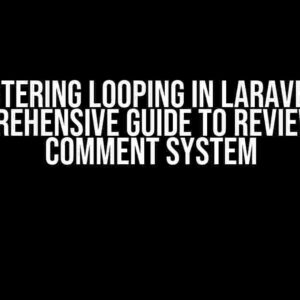Are you tired of getting frustrated with Flask’s session modification limitations when returning a stream in your route? You’re not alone! In this article, we’ll dive into the reasons behind this issue and provide a step-by-step guide on how to overcome it. So, let’s get started!
What’s the Issue?
When you return a stream from a Flask route, it’s not possible to modify the session in that route. This is because Flask uses a mechanism called “response streaming” to send the response to the client. During response streaming, Flask doesn’t store the response in memory; instead, it sends it directly to the client in chunks. This is why you can’t modify the session in a route that returns a stream.
But, why does this happen? It’s because the session is stored in memory, and when you return a stream, Flask doesn’t have the opportunity to commit the session changes to the database or file storage. This is a limitation imposed by the WSGI (Web Server Gateway Interface) specification, which Flask adheres to.
Understanding Response Streaming in Flask
Before we dive into the solution, let’s take a closer look at how response streaming works in Flask.
from flask import Flask, Response
app = Flask(__name__)
@app.route('/stream')
def stream_example():
def generate_stream():
for i in range(10):
yield f'Chunk {i+1}\n'
time.sleep(1) # Simulate some work
return Response(generate_stream(), mimetype='text/plain')
In the above example, the `generate_stream` function is a generator that yields chunks of data. Flask uses this generator to send the response to the client in chunks. This is an efficient way to handle large responses, as it doesn’t require storing the entire response in memory.
Solving the Issue: Using a Closing Function
So, how do we overcome the limitation of not being able to modify the session in a route that returns a stream? One approach is to use a closing function. A closing function is a function that’s called after the response has been sent to the client.
In Flask, you can use the `@app.after_this_request` decorator to register a closing function. This function will be called after the response has been sent to the client, allowing you to modify the session.
from flask import Flask, Response, after_this_request
app = Flask(__name__)
@app.route('/stream')
def stream_example():
def generate_stream():
for i in range(10):
yield f'Chunk {i+1}\n'
time.sleep(1) # Simulate some work
@after_this_request
def modify_session(response):
session['key'] = 'value' # Modify the session
return response
return Response(generate_stream(), mimetype='text/plain')
In the above example, the `modify_session` function is called after the response has been sent to the client. This function modifies the session, and then returns the original response.
Alternative Approach: Using a Background Task
Another approach to modifying the session in a route that returns a stream is to use a background task. This approach involves sending the response to the client immediately, and then running a background task to modify the session.
You can use Celery or another task queue to run the background task. Here’s an example using Celery:
from flask import Flask, Response
from celery import Celery
app = Flask(__name__)
celery = Celery(app.name, broker='amqp://guest:guest@localhost')
@app.route('/stream')
def stream_example():
def generate_stream():
for i in range(10):
yield f'Chunk {i+1}\n'
time.sleep(1) # Simulate some work
celery.send_task('modify_session_task', args=['key', 'value'])
return Response(generate_stream(), mimetype='text/plain')
@celery.task
def modify_session_task(key, value):
session[key] = value # Modify the session
In the above example, the `modify_session_task` function is called as a background task using Celery. This function modifies the session, allowing you to overcome the limitation of not being able to modify the session in a route that returns a stream.
Best Practices
When working with sessions in Flask, it’s essential to follow best practices to avoid common pitfalls. Here are some best practices to keep in mind:
- Use sessions sparingly: Sessions should be used judiciously, as they can lead to performance issues if not used correctly.
- Avoid storing large amounts of data in the session: Sessions should be used to store small amounts of data, such as user preferences or authentication details. Avoid storing large amounts of data, as it can lead to performance issues.
- Use a secure secret key: Make sure to use a secure secret key to sign your session cookies. This will prevent tampering and ensure the integrity of your sessions.
- Use a suitable session storage: Choose a suitable session storage mechanism based on your requirements. For example, you can use the built-in Flask-SQLAlchemy session storage or a third-party library like Flask-Session.
Conclusion
In this article, we’ve explored the limitation of not being able to modify the session in a Flask route that returns a stream. We’ve also discussed two approaches to overcoming this limitation: using a closing function and using a background task. By following best practices and using the approaches outlined in this article, you can effectively modify the session in your Flask application.
Remember, when working with sessions in Flask, it’s essential to be mindful of the limitations and potential pitfalls. By being aware of these limitations, you can write more efficient and scalable code that meets your application’s requirements.
| Solution | Description |
|---|---|
| Closing Function | Use the `@app.after_this_request` decorator to register a closing function that modifies the session after the response has been sent to the client. |
| Background Task | Use a task queue like Celery to run a background task that modifies the session after the response has been sent to the client. |
By following the approaches outlined in this article, you can overcome the limitation of not being able to modify the session in a Flask route that returns a stream. Happy coding!
Frequently Asked Questions
Flask streaming got you down? Don’t worry, we’ve got the answers to get you back up and running!
Why can’t I modify the session in a Flask route that returns a stream?
This is because when you return a response with a streaming iterator, Flask does not buffer the entire response in memory. Instead, it sends the response in chunks, which allows the client to start receiving the response before the entire response is generated. However, this means that the session is already committed to the response, and you can’t modify it anymore.
How do I store data temporarily while streaming a response in Flask?
You can use a temporary storage solution like Redis or Memcached to store data temporarily while streaming a response. These solutions allow you to store data temporarily and retrieve it later, even after the response has been sent.
Can I use a streaming response to send large files in Flask?
Yes! Streaming responses are perfect for sending large files in Flask. By using a streaming iterator, you can send the file in chunks, without having to load the entire file into memory. This can greatly reduce the memory usage of your application and make it more scalable.
How do I handle errors when streaming a response in Flask?
When streaming a response, Flask does not catch exceptions in the same way as it does for regular responses. Instead, you need to catch exceptions manually and handle them accordingly. You can use try-except blocks to catch exceptions and send an error response to the client if needed.
Can I use streaming responses with Flask’s built-in development server?
Unfortunately, no. Flask’s built-in development server does not support streaming responses. You need to use a production WSGI server like Gunicorn or uWSGI to use streaming responses.






